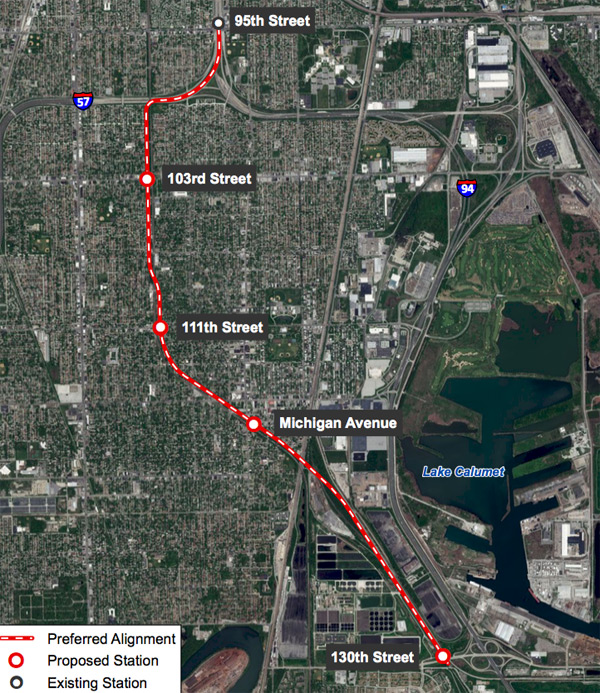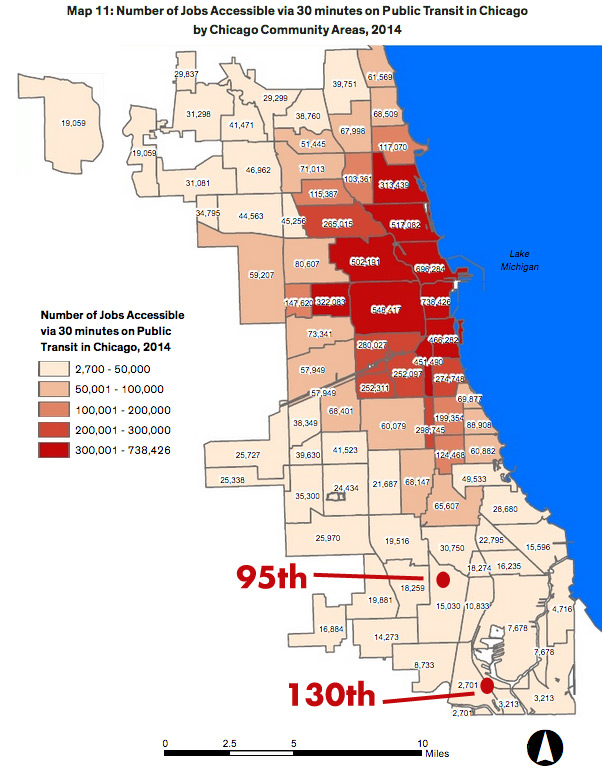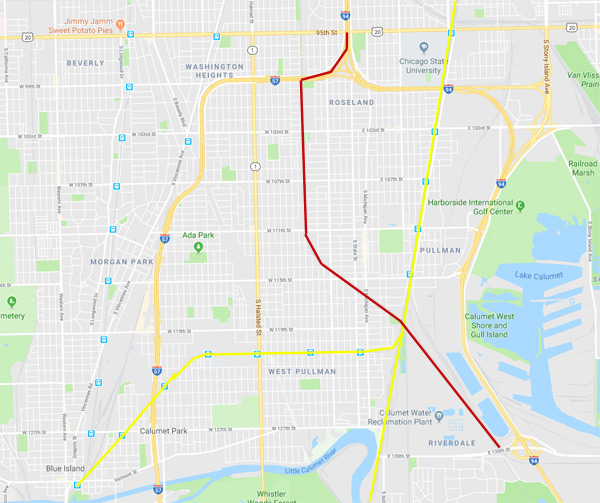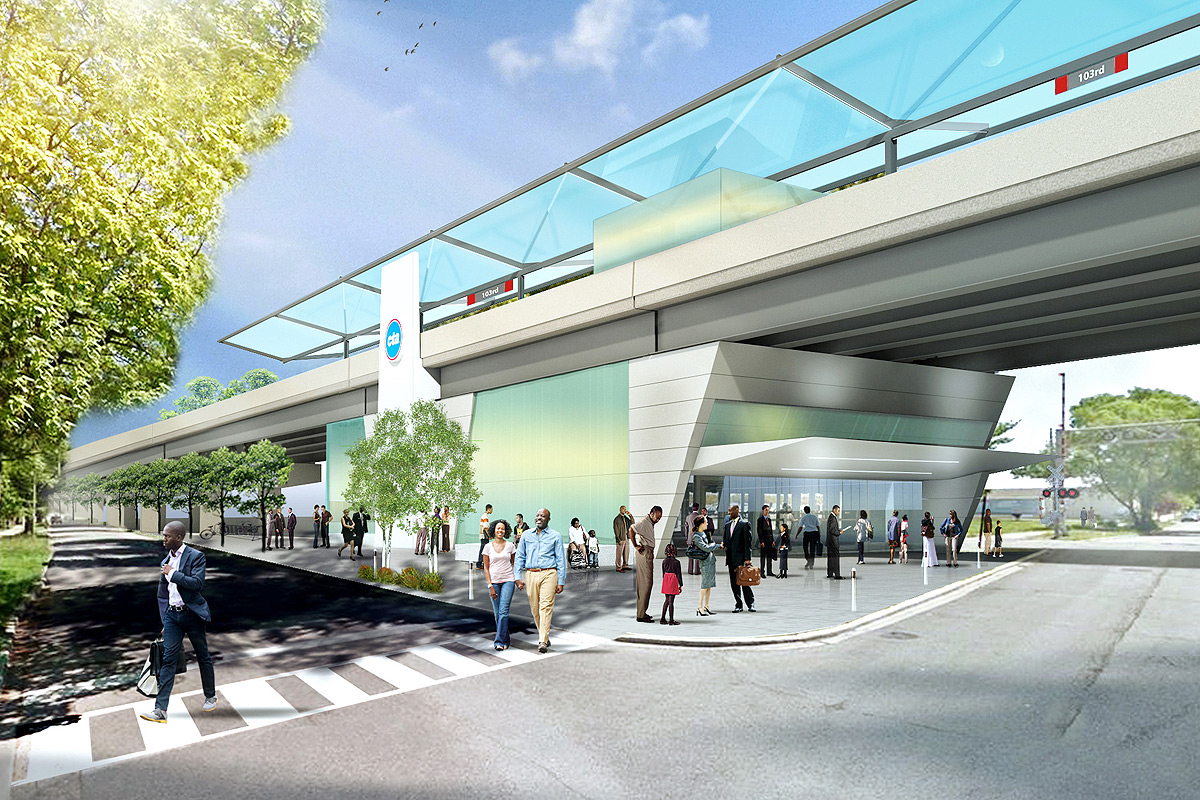The city announced its planned route for the long-discussed extension of the Red Line, which would be extended from its current South Side terminus at 95th Street down to 130th Street in between Lake Calumet and the Little Calumet River. Here's where they want to run it.

The city says it would be a 5.3-mile extension costing $2.3 billion dollars, $1 billion of which would come from the federal government. The Tribune reports that it will shave off about 20 minutes from a commute from 130th Street to the Loop. That sounds about right: According to Google Maps, it's 28 minutes from the 95th Street Red Line Station to State & Lake. Currently to get from the approximate location of the proposed 130th Street station, it's a short walk and then a half-hour, 49-stop bus ride from Ellis Avenue and 131st Street to get to the 95th Street terminus.
One map gives a sense of how that could affect commuters. It's from a UIC-Great Cities Institute report on jobs and unemployment for youth, and it shows the number of jobs available within a half-hour commute of anywhere in the city. The 130th Street station would border the two community areas with the fewest number of jobs (as of 2014) available within a half-hour commute: 2,701. I've annotated it with the location of the 95th Street station and the proposed 130th Street station.

The 130th Street station would be on the border of Riverdale, which, the Tribune's Alexia Elejalde-Ruiz reported in 2016, has the most economic hardship of any Chicago community area: a per-capita income below $7,500 and unemployment of 40 percent. Faster and more reliable public transit could be a considerable benefit for the far South Side neighborhood.
But there's likely to be some pushback. The proposed route would cost the city over a billion dollars, and the additional federal money is up in the air: The White House's infrastructure adviser said Trump's infrastructure plan "will not include any new revenue to pay for $200 billion of new federal spending," and apparently focus more on bringing non-federal money to the table. So, a near-50-percent match may not be realistic in the near future, and the situation could change again between now and 2022, the earliest time the city says it could begin.
Meanwhile, transit advocates have been pushing a proposal for many years that would convert the Metra Electric lines into something that functions more like the L, with greater frequency and a longer operating day, than the infrequent commuter rail pattern it runs on now.
The Metra Electric is highlighted in light yellow, the proposed Red Line extension in red. They cover similar territory.

If you wanted to take the Metra from Blue Island to Millennium Station on a Monday morning, the train leaves at 6:15, 6:40, 6:58, 7:20, 7:35, and 8 a.m. The last one will get you downtown by 8:56. After the 8 a.m. train, there's not another one for two hours and 18 minutes. The next trains are 12:18, 2:18, 4:18, 5:38, 6:38, and 7:41 p.m. And that's it for the rest of the day.
Going from downtown to Blue Island? The last train arrives in the latter at 8:23 p.m. It's a rush-hour train that mostly benefits 9-to-5 workers and doesn't really serve the night shift at all.
This case has been made many times. Sandy Johnston wrote a thorough piece about it for South Side Weekly last year. Steven Vance considered the idea for Streetsblog in 2016. As Johnston points out, and as you can see from the map, there are a lot of stations for the Metra Electric running through the Red Line extension area, far more than your typical Metra line—because it used to have L-level frequency and serve a rapid-transit-like purpose before it was absorbed by the RTA and run on a commuter-rail schedule.
Daniel Kay Hertz wrote that such a conversion would cost about $27 million per mile, compared to about $434 million per mile (including federal funding) for a Red Line extension. As Alon Levy writes in CityLab, the latter number is pretty average for American subway/elevated rail projects, which is far more expensive than European ones. If the $27 million-per-mile estimate is correct, that's less than half the cheapest new American construction Levy cites, a $65 million per mile light-rail project in Phoenix.
The Tribune's Mary Wisniewski reported that the idea "has drawn the interest of Mayor Rahm Emanuel, who has asked the head of the Regional Transportation Authority to facilitate discussion on the issue." It hasn't gotten far enough along to serve as a replacement to the Red Line extension, apparently. At Streetsblog, John Greenfield thinks the reason is that "they believe that it will be easier to prize a federal grant out of the Trump administration than get CTA and Metra to play nice."
If the Red Line extension does happen, it wouldn't necessarily obviate the Metra Electric conversion; the North Side has comparable north-south L density and it's a good tie-in with the Obama Library. But much as CTA and the Metra have had trouble integrating their services, transit funding is likely to run into a headwind under the Trump administration's infrastructure plan. Yonah Freemark noted that it requires value capture financing for transit funds, such as property value increases that would pay for its cost through a tax-increment finance mechanism; as Greenfield points out, that might not be a realistic goal for a Red Line extension. In this quite realistic scenario, the city might have to wait for a different administration, or do some heavy relationship counseling for the metro's two public-rail agencies.




